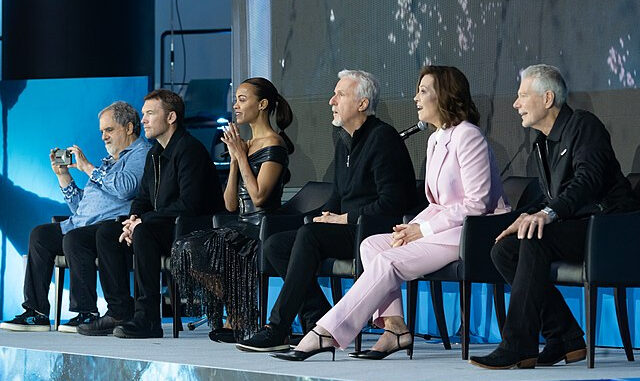
Emily Fritz | A&E Editor
For those unfamiliar with the socially-banned and outdated practices of Old Hollywood, blackface is the practice of allowing a white or non-Black actor or actress into a role that is designed for or portrayed as a person of color. For example, Egyptian characters are often portrayed as having fair or white-passing skin tones, when in reality, many Egyptians do not.
The newest variation of cultural appropriation, coined as “blue face,” is present in James Cameron’s second installment of the “Avatar” franchise, “Way of Water.” The original outcry emerged on Twitter from Asdzáá Tłéé honaa éí, and has since been made available only to her followers.
In a 2010 interview with Guardian, Cameron admitted he used Indigenous histories as a heavy influence in the “Avatar” movies, and went as far as to say that had the Lakota Sioux known the result of their plights, “they would have fought a lot harder.” As if they didn’t put their full heart and soul into fighting against the overpowering imperialism from European nations.
Not only did Cameron let his white-savior complex show during the interview with Guardian, but he also inserted it directly into his films. The main character, former Marine Jake Sully (Sam Worthington), is the Na’vi equivalent of Kevin Cosner in the 1990 film “Dances with Wolves.”
Having seen the film before the controversy became widely-known, it was an effective sequel, but it was a tired plot. The script didn’t add anything new, life-altering or thought-provoking that wasn’t already present in the original.
The technology is respectable and perhaps revolutionary, but within the context of CGI, it was easy to forget that real-life actors were performing in underwater spaces. Similarly, it was easy to forget that the actors and actresses did not fairly representw the people or culture that it borrowed so heavily from. This is where the concept of “blue face” comes into play.
Although the settings, peoples and creatures in the “Avatar” sequel are fictional, it draws strongly on real-life culture and painful pasts, thus making it inappropriate to mask non-Indigenous casting with a blue computer-generated complexion. Where the original film plays off of the Lakota Sioux as the inspiration for the Na’vi people, “Avatar: Way of Water” goes so far as to introduce and rip off a second group of people, as the Metkayina appear to draw inspiration from Polynesians as well.
And again, the characters who were Indigenous-inspired, like Neytiri and Ronal, are played by actresses Zoe Saldaña and Kate Winslet respectively, neither of whom are Indigenous.
Ironically, the other Avatar franchise, “Avatar: The Last Airbender,” received overwhelming ridicule from fans after casting white actors and actresses to portray Asian and Indigenous characters, among many other plot inconsistencies, in their first attempt at producing a live-action adaptation in 2010. Netflix is now taking a second stab at the Nickelodeon series as a live-action, purposefully casting individuals with the appropriate racial background.
So the real questions we need to ask are: How does Cameron fix this? Is the franchise salvageable during the next three installments? Will this controversy affect how the general public critiques future movies that show lack of diversity or false inclusion?
Unlike “Avatar: The Last Airbender,” I believe that it is too late for Cameron to start over with his casting. He’s presented with the unique opportunity to try a clean state because the CGI that he uses can make any actor or actress fit the likeness of an already established character. Legally though, this sounds very messy. Contractually, this cast is signed on for the entire franchise and their likeness is likely to be protected should they be recast and then pursue damages against Cameron.
Moving forward, I can’t say what the right decision is. I would think Cameron should seek counsel from the Indigenous groups that he’s wrongfully stolen from, try to make amends and proceed more cautiously and respectfully. Or, perhaps Cameron could donate a portion of the box-office earnings to helping Indigenous groups restore their lands or take a strong stance against discriminatory and divisive laws that separate Indigenous communities at the federal level, like the blood quantum laws.
Within a western, or even a global audience, it is clear that Cameron has done a great disservice to the groups that inspired him. While cancel culture is still relevant today, I do not foresee this pain point for Indigenous peoples being taken seriously or having lasting impact in Hollywood right now. The erasure of this group is deeply embedded in our society. It is shameful and unjust.
The original advocates against this movie have restricted their platforms to people that they trust, and they’ve closed themselves off. Is it right to ask them to open themselves back up to conversation that seems to be for our educational benefit and their emotional detriment?
While I believe Cameron’s intentions were to do good, he missed the mark. He is acclaimed in the film industry for implementing new technology and creating lasting culture-influencing films, like “Titanic,” “Terminator” and “Aliens,” but as of now he will not be remembered for his part in making Hollywood a more inclusive and equitable place for diversity in film or storytelling.

